España
This is a long (and long awaited) entry everyone, so buckle up! Photos here: https://photos.app.goo.gl/aEwf1xQEyV6LiYZRA
On May 26th I set off early in the morning for Hamburg, even though I had a late afternoon flight. I was very happy to be armed with Diego's backpacking pack, complete with the waist strap, a feature I had completely fallen in love with after the Brussels-Luxembourg-Sächsischer Schweiz trip in February. The comfy pack meant I was happy to just stroll around the city listening to my audiobook and hanging out with the various waterfowl along the Alster. Eventually it was time to head to the airport for my initial flight to Munich. The layover in Munich was uneventful (how I generally like my layovers to be) and before long I was landing in Barcelona.
It hurt a little bit to fork over the money for the 96 hour public transport pass, but given how much we used it, it was the right choice in the end. Before too long I made it to the airbnb where my college friend Veronica was waiting. Her post-PhD time off travel happened to coincide with the time I had planned to be in Spain, and since our friendship had been formed partly by our 8am Spanish 201 class way back in our first year at Earlham, it seemed appropriate for her to meet me there before proceeding on to Germany together.
It's always challenging to try and catch up with a friend you haven't seen in a bit while also attempting to get something done. We found this to be true as we tried to update each other about our journeys there, and other basic life updates even as we had to research what to do the next day. We eventually decided on a free walking tour of the Gothic Quarter, because I feel like that usually gives a good overview of the city. Thus it was that we spent a surprisingly hot morning strolling around Barcelona the next day, learning about the Roman tombs and other ruins, a bit about Catalan language and history, and even drinking from the famous Font de Canaletes fountain on La Rambla, a well-known pedestrian street in the city. Legend has it that the water is magical and will make anyone who drinks from it fall in love with Barcelona and want to come back-we happened to be thirsty, so we filled our water bottles. We also saw the Plaça de Sant Felip Neri, including the pock-marked stone that was evidence of Franco's bombs during his siege of the city as part of the Spanish civil war in 1938.
We also got to see the Barcelona Cathedral, which is an interesting mix of architectural styles. Construction began (on the site of a previous church) in 1298, and was finished in 1448. The original facade was in the simpler style common among many Catalonian churches, but the facade that is visible today was built over the top of the old one, in the much more elaborate new-Gothic style, and finished in 1913. This results in a rather strange mix of architectural simplicity with a layer of extreme complexity pasted over the top. We also learned that, prior to the 1992 Olympic games (which Barcelona hosted) the city could boast no beaches, despite being directly on the Mediterranean. The solution was to import tons and tons of sand from the Egyptian Sahara and build artificial beaches for the expected hordes of tourists to enjoy!
So it was, that after grabbing some falafel sandwiches from a little shop near where the tour ended, and walking in circles for a while in a vain attempt to find a park to enjoy our meal, we eventually just gave up and ate the food where we were. After this we headed back to the airbnb to change into our swimsuits and go explore the artificial beach for ourselves.
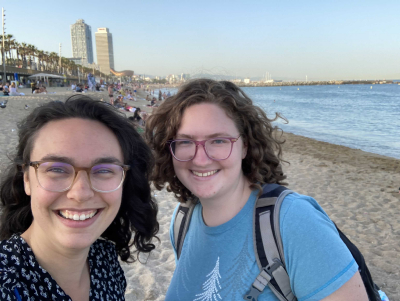
We were far from the only ones to have had the beach idea, but we did manage to find a little section where we could lay down our quick-dry towels and get out our books for a nice afternoon of reading on the beach. We did a decent job applying sunscreen, so there was only a slight rosy sunburn by the time we got hungry again a few hours later and left in search of tapas.
We didn't have to go far it turned out, and enjoyed some patatas bravas (roasted potatoes with a spicy mayo sauce) crusty bread with roasted tomatoes, as well as some fresh mozzarella and tomato salad, with Spanish wine, of course. Perhaps the best part was that it was all within view of the beach. The restaurant was far from crowded too, since at 8pm we were at least 2 hours early for the typical Spanish dinner time.
We went to bed before it was too late, despite Veronica's jet-lag, because we had another day of exploring ahead of us. We attempted to balance the "we're on vacation, let's relax!" mentality with the "we flew all this way to be in this cool foreign city, we have to see all the things!" mentality, and overall we did a decent job I thought. We didn't set an alarm, but woke up in time to grab some pastries for breakfast and some coffee for Veronica and head to the iconic Cathedral of La Sagrada familia, designed by Antoni Gaudí. We decided we didn't need to pay the 50+ Euro entrance fee to see the inside (recently graduated PhD students and Fulbright teaching assistants aren't made of money, after all) but we did walk around the outside, and take in the unorthodox architectural style of the classic Barcelona landmark.
From there we headed to the Barcelona history museum, where we spent an incredibly long time in the one-room special exhibit on food supply and public health, chuckling at some of the English translations of the plaques. We then descended into the basement where pathways had been set up through the Roman ruins. As people from a more recently inhabited continent, it really was fascinating to see evidence carved in stone, of people having lived right where we were standing for well over 2000 years. We got to see where the laundry was done and the cloth was dyed, as well as where the fish was processed and stored. Quite interesting.
We eventually emerged aboveground, blinking like a couple of moles in the bright midday sunlight. After learning all about the various markets (or "mercat" in Catalan) in the museum's exhibit on the history of Barcelona's food, we were inspired to make our way to La Boqueria market to find some lunch. We were rapidly adjusting to the Spanish meal schedule, mostly accidentally, but it did turn out that our lunch didn't happen until 3:30, much closer to the typical local mealtime. We were not the only tourists to have this market lunch idea, and the market was packed but we did manage to find some vegetarian paella which was pretty good, and then to snag some ice cream and a fruit cup complete with dragonfruit for later snacking.
We did some good old fashioned aimless strolling about the city in the afternoon, and eventually made our way to Parc del Turó de Putxet, which meant we had to take a bit of a hike uphill. The views of the city, including La Sagrada Familia and the shimmering blue Mediterranean beyond were well worth it, however. We found a shady bench and enjoyed our now rather warm but still tasty fruit cup while watching what must have been a small local summer camp or after-school activity group play some games which involved the kids running up and down the hill.
That night we got a loaf of bread, some cheese, a bit of fruit, an avocado and best of all: olives stuffed with pickles! We ate our snack dinner back at the airbnb and were thinking of maybe going out that night, but we ended up being too tired to break free of the gravitational pull of the house, so we just stayed in after all.
The next day, after our routine coffee and pastry breakfast, we decided to head out to a different stretch of beach in the morning. We did put on sunscreen, I swear...but we succumbed to the classic pitfall of not re-applying after we had been there a while... We also spent more time bobbing up and down in the waves this go around, so we were pretty red by the time we left to get some food. My experiences in Copenhagen and years ago in Paris had given me a deep-seated mistrust of Mexican food in Europe, but I figured that since Spain was the country that had invaded Mexico, there was a better chance of decent tacos, so we went for that.
Veronica acknowledged that they were alright, but to my taco-starved palate they were delicious. We hung out there for a while and then headed out for our next adventure, passing L'Arc de Triomf that was built to welcome people to the 1888 Barcelona World Fair on our way to the botanical gardens.
It took quite a bit of walking and a bus to get us there, such that by the time we arrived at the Jardí Botànic de Barcelona they were only 45 minutes from closing, which contradicted what google had told us about the hours. Thus, we had a rather more speedy tour of the impressive gardens than we would have liked, zooming through various biomes and admiring the palms, pines, flowers and shrubs along with the pond and the wonderful views of the city at a rapid pace. We did manage to see enough for me to conclude that it was probably the most impressive botanical garden I've ever been to. The Mediterranean climate allows them to grow a lot of plants that would otherwise need to be in a greenhouse outdoors, I suppose, which does give them a big advantage.
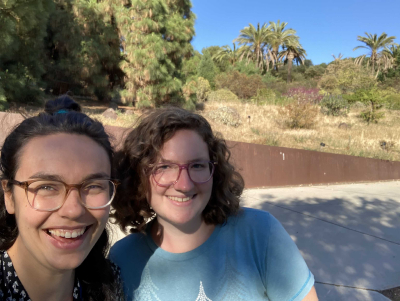
That evening's big adventure was my late-night trip to the 24 hour pharmacy to pick up some aloe vera for our sunburns. I learned how to say sunburn in Spanish ("quemadura de sol" if anyone was wondering) which was the only real silver lining. We slathered ourselves in the stuff after our carefully tepid showers, and hoped not to peel.
The next morning we had to get moving early, so we could make our train to Pamplona. We had gotten the unfortunate news earlier in the week that Tyler (our mutual friend from Earlham, who I studied abroad in Ecuador with) had tested positive for COVID, so we weren't really expecting to see him in Barcelona, even though he had originally planned to be there and take the same train back to Pamplona with us. Pamplona was his home base as he was finishing up his masters program, which was the main reason we wanted to go and visit him there. We were pretty surprised then, to encounter him in line waiting for the train! Apparently Spain has no more quarantine rules of any kind, but they do still require masks on all public transportation...which seemed a bit backwards to us.
It was very interesting comparing the Spanish train experience to the German one. In Germany there's no security of any kind in the train stations: you can just waltz right in and go to any platform and board whatever train you want, and sit in any available seat that doesn't say "reserviert" unless you were the one who paid 4 extra Euros to reserve it, in which case it's all yours. Then, at some point during the journey the conductor comes by and asks for your ticket, and if you don't have one you have to either buy one then or pay a big fine, as I understand it, depending on the kind of train.
In Spain, it was a strange combination of an airport and a German train station. We had to put our backpacks through the scanner and I think maybe we walked through a metal detector too, presumably to make sure we didn't have any guns or giant knives with us, because no one cared about liquids at all. Then we waited in a giant line inside the station with what looked like way more people than would fit on one train, and our tickets were checked there. Next, we had to proceed to our randomly assigned seats. My seat was in the car next to Veronica's which was on the opposite end of the train from Tyler's. Fortuitously enough, someone asked me to switch to a seat a few rows behind Veronica. This made it much easier to share the leftover bread and cheese for lunch.
I was surprised to see a flight attendant-style cart moving the length of the train handing out free "toallitas" and a subtitled telenovela begin playing on the screen. I mostly just listened to my audiobook and enjoyed watching the countryside change as we headed north. The hills got much greener and less desert-y the farther away from the more arid south we got.
Upon arrival we decided that since Tyler's symptoms had started almost a week ago, and this was his second bout of covid we would just mask up in the house and stay with him anyway, since we would have our own rooms in his surprisingly spacious 10th floor 3 bedroom apartment. We spread out in the giant living room then, opened the windows to the warm air and enjoyed the views of the mountains as we caught up with Tyler a bit. Veronica and I set out on a walk to explore the city and get some groceries later that afternoon while Tyler was in class.
Pamplona is most famous for its San Fermin festival, better known as "the running of the bulls" which sounded pretty terrifying and we were not sad to be missing, despite its cultural importance. We strolled through the lovely narrow streets and noted the clam shell design that marked the path of the famous "Camino de Santiago" pilgrim's way that has become a popular hiking trail. There are many paths, since the point of a pilgrimage is the walking to a place, not necessarily how you walk, but the most popular route starts in the nearby French Pyrenees and ends in Santiago de Campostela in the far northwestern corner of Spain. We were inspired by the idea of doing at least a short section of the Camino, and the fact that Tyler would be getting less and less contagious everyday gave us another incentive to get out of the house in the early part of our visit.
So after a pasta dinner, we booked a room at a hiker's hostel in Puente la Reina, the recommended overnight stop if one starts in Pamplona. Since we would only be hiking two days, with one overnight stay in a hostel rather than a tent, we hardly needed to bring anything but water and PJs, so we agreed to combine our things into my smaller pack and trade off carrying it, rather than each taking a mostly empty bag. We got all packed up that night, and prepared to set off early the next morning to beat the worst heat of the day.
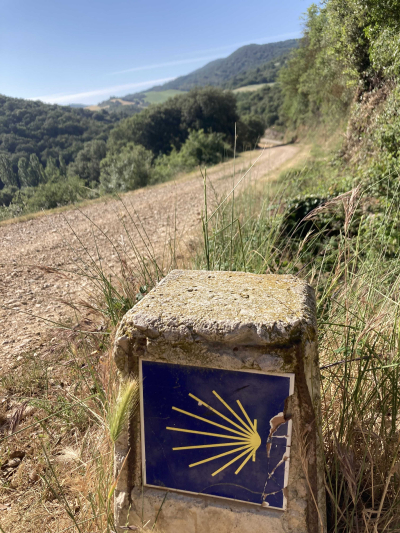
It took longer than expected the next morning to find a grocery store with lunch provisions that was open early enough, so unfortunately it was almost 9 by the time we bought our bread, traditional Basque sheep's cheese, apples and chocolate. We set off happily though, and I took the first pack shift. We followed the yellow shell motif on the blue signs to find our way among the city blocks at first, and then along roads and between fields before too long. Since Veronica and I both come from farming/gardening families, we often discussed what each crop we passed might be. Over the course of the two days we identified lots of poppies among the wheat fields, several groves of olive trees, a few vineyards, a field of baby sunflowers and what we were pretty sure must be the white asparagus know as Spargle in Germany, grown underground without any sun to make it turn green.
In contrast to the US backpacking experience that tends to be very much in the wilderness, surrounded by few other humans, the Camino is a much more communal endeavor. Right away we started meeting fellow hikers, easily identifiable by their big packs, many of which were decorated with ceramic replica's of clam shells. Because the world really is pretty small, the first pair we chatted with were a woman from Denmark and and guy from Milwaukee Wisconsin! We would continue to catch up with and be caught up with the same people throughout the day, which was sort of fun too. We wished them a "Buen Camino" as they passed us, stopping a while later at the top of a hill to switch the pack and get some water. The pack was really not heavy at all, but without it I still felt so light, carrying absolutely nothing, which was wonderful. Another hiker came up behind us then, an older Spanish man who told us he had been behind us for a while, and always knew the way to go from where we turned. It felt odd to have inadvertently acted as a guide for a local! I was also intrigued to see that his pack was on a little cart attached to a waist strap, rather than on his back, and as we continued on we would see a few others with the same setup.
I had thought I was being generous, offering to carry the pack first, but the result was that it was then Veronica's turn on the biggest uphill section of the day when it was also much hotter... Luckily there were several fountains where we could fill up our water bottles along the way--that's the benefit of centuries of pilgrims walking the same path: eventually there's quite a bit of infrastructure that develops.
After topping the highest of the hills for the day, called the Alto del Perdón due to a less prepared pilgrim's adventures, when he was tempted by the devil who offered to show him where there was a fountain in exchange for his soul. The pilgrim refused, but apparently still needed forgiveness for even being tempted, hence the name "mountain of forgiveness." We found a shady bench on the way downhill and stopped for some lunch. Almost anything tastes pretty good when you've been hiking all morning, but the hearty bread and cheese (even in it's rather warm and sweaty state) really hit the spot.
The afternoon got progressively hotter as we walked on, and although the landscape continued to be gorgeous, we were happy when we reached Puente La Reina and found that our hostel was right on the edge of town. We gratefully set down the pack (I think Veronica had it again after switching back and forth once more) and waited to check-in to our room in the shade. We got our key and followed the directions to our the private room. It proved extremely challenging to open the sliding barn door however, as it was rather jammed. Several of our fellow guests attempted to assist us, but eventually we had to give up and go back out to the overwhelmed and slightly grumpy check-in guy and get him to help us. After being skeptical about how hard it could possibly be to unlock a door, even he had to admit that it was pretty stuck.
We did eventually get it open however, and were somewhat puzzled to find that although we did have walls separating our room from the others, the ceiling was just cloth, and therefore did very little to block out either sound or light...The beds looked clean and comfortable however, unlike our sweaty and dusty selves. We decided to shower as the first order of business, and then we set out to find some provisions for dinner and breakfast.
We returned and ordered beers from the hostel to drink as we dug into our grocery store salads, and a shared pre-made tortilla de patata. For those who don't know, a tortilla de patata has nothing in common with the flour or corn tortilla we know from Mexican food in the US, other than both being vaguely flat. The Spanish tortilla de patata is made of boiled potatoes and fried onions held together with egg and cooked without stiring in a pan before being flipped and fried on the other side. It is normally served in pizza-style slices and eaten (like everything else in Spain, including Lo Mein noodles, according to Tyler) with a thick slice of baguette. I was lucky enough to have already tried many a Spanish tortilla since it was a crowd favorite brought by my Spanish coworkers the year before to all the school potlucks (or pitch-ins as they're apparently called in Indiana.)
Our grocery store version was not the finest form of the iconic culinary staple, but it was edible, and we were hungry. We chatted with some fellow hikers as we sipped our beers: a guy from Austria who was suffering from severe blisters, despite having done the entire Camino multiple times before, a woman from England who was a first-timer and also had lots of blisters, and one of our countrymen, from Georgia whose feet seemed to be in good shape.
I also managed to have a nice long chat with Adam that evening, who was off in NYC, having his own adventures. We went to bed before too long however, since the plan was to set out at around sunrise so we would make it to our endpoint for the next day before the worst of the heat arrived. This is when we discovered that the cloth ceiling isn't a perfect system...We were right by the bathrooms, so not only did we hear the not-so-quiet whispers of the later-to-bed crowd and then the shuffle of tired feet on the way to the bathroom all night long, the automatic light in the hallway was also motion-activated, so it lit up our room pretty well through the translucent fabric as well...Then of course the not-so-quiet whispers started up again by 5am, so we were both awake well before our alarms, and managed to eat a more leisurely breakfast of leftover tortilla and set out even earlier than expected.
The next day's hiking was much the same in its heat, conversation, and beautiful views. We happened to be there right at the peak of the Spanish broom plant's blooming season, so the scrubby bushes lit up the hillsides in brilliant yellow, which contrasted to great effect with the clear blue sky, especially as the rising sun hit the hilltops almost from below, setting it aglow. It emitted a lovely scent that is rather indescribable, as scents so often are.
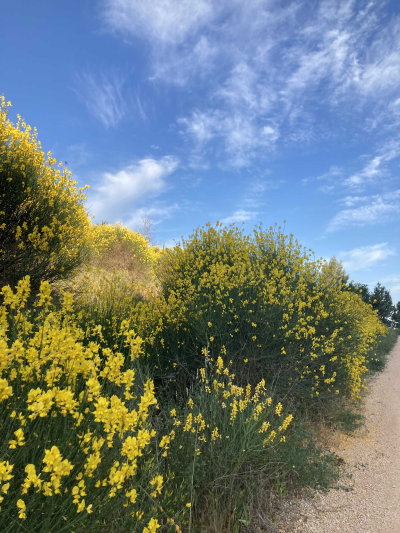
We ran into several of the folks we had seen the night before at the hostel along the way. At one point, when Veronica was wearing the pack (I let her have the cooler morning shift this time) we passed a woman who remarked to me, in a heavy accent "You are light!" gesturing toward my unladen back as she lugged her heavy pack up the incline. It was true, for half the time I was quite light, and knowing that we would be on the bus back to Tyler's apartment, some AC and a much quieter bed for my siesta made the increasing heat manageable.
We did in fact make it to Estella, our final destination in time for lunch in a shady park. We then strolled across town to purchase bus tickets that would take us (in less than an hour) the distance that it had taken us 2 days to walk. We had gone 22.3 kilometers the first day, and 25.3 the next, for a total of about 29 and a half miles. We tried not to be too demoralized by our human feebleness when compared to the mighty bus, and instead enjoyed some iced coffee and tea in a cafe near the bus station.
Back in Pamplona, after some much needed siestas and showers we ordered pizzas from Tyler's favorite restaurant. There was a funny moment when the lady behind the counter asked Veronica to confirm the telephone number for her order and Veronica, having understood the rapid-fire Spanish perfectly, nodded and said, "Mi numero de telefono es..." and then automatically rattled off her phone number in English. The best part was that she didn't even realize she had switched languages until the three of us (the clerk, Tyler and I) started chuckling. It seems to me that numbers, for some reason are one of the hardest things to do in another language. Even the most fluent near-native speakers I know still count in their own languages.
There was no dine-in area at the restaurant, so we went to a park to eat outside and (and continue to keep our distance from Tyler) as we overlooked the city as the sun set. The sun sets later there in June, closer to 10 pm, so we were really getting good at the Spanish dinner time! It was nice getting to catch up with him a bit more and to watch the parade of dogs march past on their evening strolls.
The next day was fairly low-key. We walked over to the "Museo de Navarra," the museum for the northern Spanish state Pamplona is part of. We enjoyed walking through the exhibits there, starting with pre-history and moving on to the middle ages and up to the present. In contrast to the Barcelona history museum, there wasn't much signage accompanying many of the historical artifacts and artworks, so it relieved the pressure to read all the long (interesting!) but tiring explanations contextualizing each piece in the broader historical narrative. This meant that we felt satisfied to have adequately "done" the museum's many floors without getting too exhausted by all the standing around and reading. This faster pace also meant that we could see what we wanted to see during the morning's open hours rather than having to come back again in the evening.
That brings me to a topic I haven't discussed yet, but we had quickly realized is very important to the Spanish: the siesta. I was a bit shocked to find how seriously it was taken. I sort of assumed that it was an old custom that most modern, working people didn't follow, since who can afford to just take a nap in the middle of a work day? While I was partly right in that most people don't necessarily sleep, the idea of resting at midday is a foundational principal in Spanish scheduling. The entire country's day is structured around it. Case in point, the museum's hours during the week are 9:30-2 and then it is closed until it reopens again from 5-7. So the number of total open hours isn't much different from museums in the US, but that siesta time is sacred. It is sort of nice how egalitarian it is though, that everyone gets a siesta, even museum workers. They are sort of on to something too, as we discovered while walking the camino, it gets pretty unpleasantly hot to be outside for those couple of hours in the middle of the day.
So after our own siestas, we ventured back out to the famous Beatriz bakery to get some white chocolate and dark chocolate "garroticos" as Tyler recommended. I had never heard of them, but these dense, buttery little pastries are made of layered dough similar to Baklava, but instead of oozing honey and pistachios they are formed into a more bun-like shape and are oozing some kind of chocolate. We had to wait in a line out the door before being let into the popular local shop, and we got our half white chocolate/half dark chocolate box, as instructed. We attempted to eat some on the way home, but after one particularly gooey and sweet white chocolate bite, we decided we needed to go back to Tyler's and make coffee to go with them. The rest of that evening was pretty uneventful, aside from making plans to visit the little town of Olite the next day.
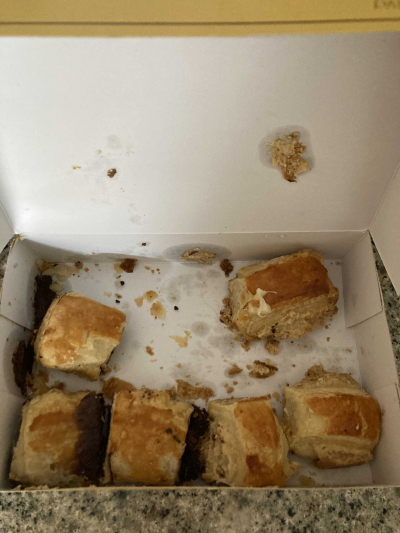
We packed our day bags and set out the following morning, and were off to a great start until we ended up getting lost in one of Tyler's favorite parks and nearly missing our train. We did in fact make it in the nick of time though, and settled in for the short ride. Before long we heard the announcement that the next stop was Olite, and we began gathering our things, making it to the door just as the train pulled to a stop in the tiny station. We waited a moment for the door to open, and when it didn't, we looked around on the door for the button to push that would open it...aaaand we found the button next to the door juuuust as the train pulled away from the stop. Oh dear.
We decided to get off at the next stop and hope we could either walk or find a bus from there to Olite. The next town was somehow even smaller than Olite, and a quick google maps search quickly ruled out the idea of walking back to Olite, since it would take several hours (a few minutes on the train covers a lot of ground!) and we wouldn't have time to see much of anything before needing to get back on the train to Pamplona. The next best option seemed to be taking a bus from Marcilla (where we were stranded) west to the slightly larger town of Peralta, and from there catch another bus back north to Olite.
So we walked along the busy sidewalk-less road into the "city center" such as it was, in Marcilla, and thanks to a kind stranger, eventually found the bus stop on the correct side of the street. We were reassured to confirm that the mom and son waiting next to us where also headed to Peralta, a good sign the bus would actually come. It was a bit late, but it did show up, although it turned out to be more of a van with a little sign in the window. But it did in fact get us to Peralta! Part one of our mission was accomplished. Once in Peralta, we had a little time before the next bus was scheduled to come, so we went to a nearby cafe and ate some fresh tortilla de patata, which was tasty.
We finished our breakfast in time to be at the stop early, which was good, since it gave us time to figure out where the stop actually was. It turned out not to matter though, because the bus just...never came. After waiting like half an hour after it was supposed to have arrived, we finally bit the bullet and just got a 30 Euro taxi to Olite. It was super frustrating to have to pay more than both of our train tickets to and from Olite cost because of a stupid mistake. It would have taken us 2 more seconds to figure out how to open that dang door, if the train had just paused a teensy bit longer...but we decided it was better to just get to where we wanted to go, enjoy the afternoon and not dwell on what was done.
Luckily Olite, and specifically the castle there were really cool, so it felt worth it to have decided to get there, despite everything. The castle looked like a real life sand castle, and I have never felt so much like a princess. It is a unique mix of castle (in the sense that it has the classic fortress-like defenses of a military stronghold) and also a luxurious palace on the inside. It was built on the sight of previous Roman ruins in the thirteenth century, and was intermittently occupied by the royal families of Navarra until the crown of Castile took it over in 1512. The palace was significantly damaged when Navarese guerrilla fighters set fire to it to prevent French troops from occupying it as a fort in the Napoleonic invasion of Spain, and so a lot of the fancy palace-y interior was lost. The stone exterior was significantly reconstructed starting in 1937, from the ruins it had fallen into, and although they did take a few liberties (the tallest tower is now a bit taller than the original, etc) they did a remarkable job restoring the overall look.
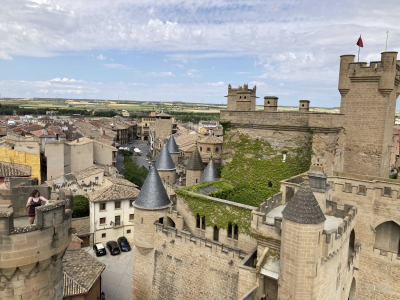
We had a great time exploring every nook and cranny, imagining we were royal children getting to grown up surrounded by crenelated turrets, and looking down on the Queen's orangery in the center of the compound. It was also really neat to see the old before and after photos detailing the restoration work that went on. Once we had admired the view from each tower and read up on the various Monarchs who had made their homes there over the centuries, we headed out to peek into the church. The altar featured lots of colorful paintings, but other than that was fairly small, so it wasn't a long visit.
We then strolled though the city for a while, perusing the touristy little shops before deciding on a place to grab some lunch. We ordered sangria, since we hadn't done that yet, as well as some fried cheese balls and sandwiches. The cheese balls were alright (that's hard to screw up) but the sangria had lots of undissolved sugar in the bottom and the sandwiches had way way too much mayo (and I actually like mayo!) but at least it was a nice spot where we got to watch the comings and goings of the main square under a shady awning.
That was pretty much all we had time for, since we wanted to head back to the station to avoid any more transportation mishaps, having had enough of those for the entire trip! Thankfully, the ride back to Pamplona and the walk from there to Tyler's apartment was soothingly uneventful. We took some nice siesta time before getting dressed and heading out to a traditional Basque restaurant for dinner. I was very impressed that Tyler recognized that I was wearing a dress I had bought on our beach trip in Ecuador back in 2015! The guy has a great memory apparently.
He recommended I read "A Basque History of the World" before coming to Spain, and although I hadn't made it all the way through, I had read enough to be excited to try the distinctive cuisine of this fascinating people. The first exciting experience, after deciding on which dishes to select in our multi-course meal, was the cider pouring. Each "menu" came with your choice of either a half bottle of wine or a whole bottle of dry local cider. It has to be poured through a special cork with an opening through it, and from about 2 feet above the glass, in order to properly aerate it. It is inevitably messy and fun to pour, and ended up being delicious. The other interesting aspect of the meal was my dessert: a soft yogurt-like sheep's cheese drizzled with honey. The cheese had a pretty strong flavor, but was actually quite tasty.
We enjoyed a typical "sobremesa," which literally means "over table," but is a specific term used to refer to the post-meal conversation that Spaniards can make stretch for hours. We had arrived at maybe 8:30 I think, so on the later end for a dinner reservation in the US, but we were the absolute first people to arrive at the restaurant. By the time Adam called me to check in it was nearly 11 and Tyler jokingly said "How rude, it's nearly 11 here, doesn't he know that's dinner time?!" and it actually still was.
The next morning, Veronica and I tested negative for covid (yay!) and headed out to go see the Pamplona Cathedral before our train left for Vitoria-Gasteiz. Since there was a special event going on, we didn't get to spend much time in there before we felt like we were intruding and headed back. We didn't end up having to pay for our quick look though, which was a plus. With that it was time to pack up again, say our farewells to Tyler and board out train en route to visit my friend Susana, the former 3rd grade teacher at the school I had worked at in Indianapolis.
The journey was largely uneventful, and Susana met us on the platform with a huge hug. We had a very "small world moment" as we walked to Susana's apartment: Veronica is from South Bend Indiana, and when Susana heard that, she said "Oh my roommate in Indianapolis was from there too! I wonder if you know her?" And I was thinking 'there's no way, South Bend isn't that small of a city' but after clarifying the former roomie's last name it turned out this girl had been on the same high school swim team as Veronica! What are the odds?!
We soon arrived at Susana's adorable little downtown apartment in a building that was casually centuries old... This gave it the adorableness, but also the need for the major repairs that were underway. We got the tour of her apartment despite its in-progress nature. It was very clear it would be perfect for her once it was all done: the exposed heavy wooden beams gave it a cozy rustic feel, and the spiral staircase going up to the top level was really charming. We dumped our backpacks there, met a couple of her neighbors in the hallway, and went on the Susana-guided tour of her city.
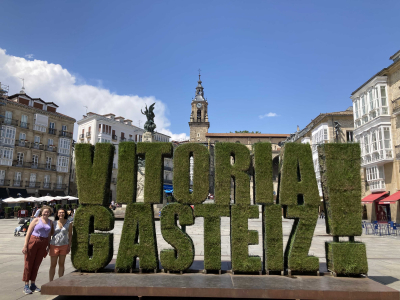
It's always cool to get a tour from a real local, since we got to learn not only all about the different layers of the city walls as they expanded, but also some more personal anecdotes from her childhood there. There was also a marathon going on in the city that day, so after getting the basic lay of the land in the capitol of Basque country, we sat at a cafe, had some wine, and cheered on the runners as they turned up the hill for the finish.
We then moseyed our way (on the tram) back to her parents' house, where she was staying while her house was remodeled. The village where she grew up is called Abetxuko but is pronounced "Abi-choo-co," and the Basque origin of the name explains the spelling. We heard all about the traditional Fiestas de Abetxuko that Susana has gotten very involved in planning, and heard more about the local history from a Basque local herself. Although she is not ethnically Basque, her parents having come from southern Spain for work, she grew up going to local schools in Vitoria-Gasteiz (Vitoria being the Spanish/Castillian name for the city, and Gasteiz being the Basque name for the same place) and she therefore learned to speak Basque in school. By their own definition, the fact that she can speak the language makes her a Basque herself, despite her heritage. This is an interesting way of defining in-group/out-group status that I hadn't seen before, but it has proven helpful for this small ethnic group to maintain their political autonomy throughout (most of) the many upheavals in Spanish history.
We relaxed a bit once we got to her parents' house, and since they were out of town Veronica and I each got our own rooms once again. Eventually we got ourselves a bit dressed up and then hopped back on the tram to head into the city where we would meet Susana's cousin and friend for a night-out. After introductions were made, they explained that their going out system is to all put in X amount of money into a designated wallet at the beginning of the night (drinks are ridiculously cheap in Spain, so I think it might really have been 10 Euros each) and that way anyone can take the wallet and get a round for everyone without the need for 5 tabs or any complicated tipsy accounting. Then whatever is leftover just gets transferred to the next night-out or divided back up amongst everyone later--not a bad system, as long as everyone is sticking to beer and wine and isn't concerned with a few cents of discrepancy in amount paid.
We were keeping up pretty well with the Spanish, but as the venues got louder and the night went on, we slipped into some combination of Spanglish in oder to ensure maximum communicative viability for all (or max confusion, depending on who you ask.) We eventually headed to dinner around 10 or 11, and enjoyed sharing a couple of plates in true tapas (or pintxos "pinchos" as the Basque version are called) fashion. Susana's cousin was worried for our heads and stomachs the next day, since Veronica and I were switching between wine, beer and more of that fun Basque cider, but she eventually decided that we were young enough that we could get away with it. Especially since we were really only getting one drink at each place, dancing for a while, and then walking to the next place, and drinking some water in between, the total amount of alcohol consumed wasn't really so worrying. We had a great time dancing the night away and singing along to some of the reggaeton favorites familiar from the US, and well as groovin' to some new Spanish tunes. We eventually got a taxi back to Abetxuko well after midnight and crawled into bed exhausted but content.
The next morning we woke up at a leisurely pace, and headed to our guided tour of the old cathedral, or Catedral de Santa María de Vitoria. We ended up getting the little devices that provided the English audioguided version of the tour, but we walked along with the group getting the same information in Spanish, so it was fun to compare what I could catch of the Spanish with the English. It was interesting how much the tour focused on the history of the restoration of the Cathedral rather than on its original history. I was quite impressed with the tour actually: we started in the basement to see the ruins of the former churches on that site, as well as the major restoration work that was required on the foundation to save the church from crumbling. We then headed upstairs to note how many of the Gothic arches are not...quite...even...requiring yet more stabilizing reconstruction throughout the years. We even got to go upstairs and crouch as we walked around what felt like secret passageways looking down over ornately carved stone railings onto the main altar. We saw the way that the gigantic wooden support beams in the ceiling were themselves supported by steel cables, added later to keep the whole thing from crumbling. We got to look out from the bell tower over the beautiful city, before descending to watch a light show (similar to Lichtwoche in Rostock and the Bright Brussels event Selina and I found) illustrating the various colors and designs of paint that had adorned a certain alcove over the years. Overall I think it was one of the best tours I have ever been on. I liked their commitment to stabilizing the building structurally, without hiding the imperfections that led to the need for those restorations, they kept it all visible as part of the story of the building.
After emerging back into the daylight, we found Susana waiting for us (she had just been on the tour recently while hosting another former colleague from our Indy school) and we went in search of some pintxos. This, she informed us was the real pintxos experience, since last night all of our food had been at one single restaurant, now we were in for the real Spanish snack-and-move-on pintxos experience. Traditionally you go to restaurant that looks good, head up to the bar and point to a couple of bite-sized nibbles that entice you, enjoy them with a glass of wine, perhaps, and then repeat the process a few more times until you feel full-ish. Trust the Spaniards to find a way to stretch out meal time to take up several hours. It is certainly not what could be called efficient, but that's actually not my goal when it comes to a Sunday afternoon meal: enjoyment and conversation are what I'm really aiming for, and the pintxos stroll-and-eat style does indeed lead to savoring, of both food and conversation.
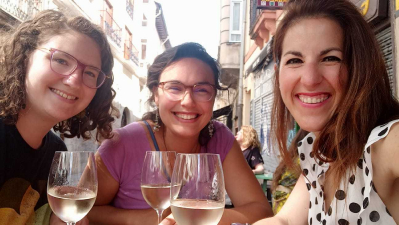
After enough wine had been sipped, and the juice from delicious mushroom-skewers licked off our fingers, we decided to head over to the Artium museum, or the museum of contemporary art of the Basque country. As I've mentioned, I love a good art museum. Susana and Veronica both were talking about how they're not always sure they understand the art properly, and I talked about my secret to art museums: I don't try to "get it" in any "right way" I just let the pieces intrigue me and provoke whatever thoughts they do. I think that's what art is supposed to do, if done well: make you think and reflect. When we had thought and reflected sufficiently, we headed out and strolled about the town a bit, stuck our heads into another cute little church, and walked past several impressive buildings while chatting and hearing more about growing up in Basque country.
We eventually headed back to Abetxuko where Susana made us a tortilla de patata from scratch, with many apologies that it wasn't nearly as good as her mom's and we had to come back to try her mom's superior version. Despite all this, and even if it didn't flip perfectly it was still quite delicious. After showing us some pictures and videos of the Fiestas de Abetxuko, as well as some googled images of the San Fermin (running of the bulls) pictures from Pamplona (she had never been but had more context in explaining it) we headed to bed in preparation for our early bus back towards Barcelona the next day.
We woke early and said a quick goodbye to Susana before taking the last of the communal bar money that was leftover and buying ourselves tram tickets to get to the bus station. Despite our ~ADVENTURES~ in Olite, we decided to make our day of transit more interesting, if also more potentially disastrous. We had elected to take the early bus to Zaragoza in order to have a longer layover and see the sights of Aragon, having already explored a bit in the states of Catalonia, Navarre and Álava in Basque Country.
Luckily, unlike in Olite, we made it to our destination with no issues, and even managed to find a place to store our giant backpacks in the bus stations so we could have a lighter load for the day's explorations. We emerged from the stations into the extremely hot and dry city. Our first stop, we decided, should be the cathedral, since it was the main thing we wanted to see, and we didn't know how long it would take. We mentally bookmarked the impressive Aljafería Palace, home of the Taifa, or independent Islamic kingdom in the middle ages as a place to return to.
But first, breakfast, since we hadn't eaten at Susana's. We stopped in at a market on the way to the cathedral, and we ordered some empanadas. I took the risk and got one whose ingredients I didn't recognize. My "oder the weirdest thing on the menu" philosophy does occasionally backfire when what I order turns out to be meat which I don't eat...So Veronica nibbled at mine as well, and then we did another loop through the market and found a pastry for me to have instead. Thus fortified, we continued our touristing.
If the old Vitoria-Gasteiz cathedral had had the best tour, the Zaragoza Cathedral, Catedral del san Salvador de Zaragoza was the most impressive church I think I've ever been in. Granted, I've never been to Italy, but I will say I have seen my fair share of impressive churches, so that is really saying something. The sheer size was one thing, and the height of the ceilings alone were quite impressive. We were not technically allowed to take any pictures inside, so the two I snuck were covertly snapped and therefore don't adequately convey the grandeur of the space. That being said, the audio guided tour we got was definitely not as interesting as the Vitoria cathedral's had been. This one focused on the specific saints honored in each alcove along the sides, rather than on the history and restoration process. It did get a bit repetitive after a while, although it was interesting to see the vastly different styles on display in each alcove, based on which family had paid for its decoration and when it was done.
After working our way through the audio-guide, we stuck our heads into the tapestry room, and marveled at the exquisitely woven patterns, reminding me of the Rosenborg castle in Copenhagen. We eventually emerged into the bright sunshine once more, and were able walk across the square to the Basilica de Nuestra Señora del Pilar, where we could use the same cathedral entrance ticket to take the elevator up to the tower and look out over the city. The winding Ebro river was almost shockingly green against the otherwise brown-toned landscape. The city sprawled out before us, and we enjoyed the intricately tiled roof of the cathedral below as well as the many elegant bridges spanning the river.
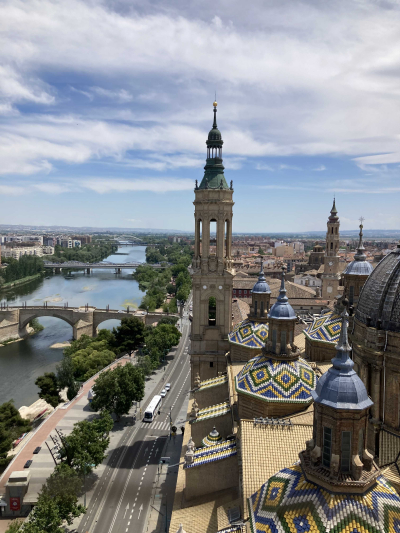
After all this, it was definitely time for some lunch, so we descended once again and made our way to a restaurant. We were happy to soak up some bread in olive oil and red wine vinegar as we waited for our food, and I sipped the "Vermut" that Susana had suggested we try (it turned out to be sweet vermouth with club soda, pretty good!) while Veronica stuck to wine. We had decided to order more patas bravas and then the Wisconsin girl I am at heart couldn't resist ordering the "cheese salad" which turned out to be delicious and not even as heavy as it could have been. Lots of lettuce balanced out the brie, chèvre, blue cheese, and another type of unidentified but delicious soft-cheese, but it was a good thing we were sharing, because it ended up being quite a lot of food!
It was also pretty wonderful how well the timing worked out, because we were just finishing our massive lunch, without having to hurry or awkwardly loiter for an extra long "sobre mesa" when it was time to head back to the station. This meant we didn't have time to return to Aljafería Palace, unfortunately, which is too bad, since a quick wikipedia search revealed that it is one of the three best examples of Hispano-muslim architecture in Spain. But on the other hand, we had accomplished a lot for a quick layover, and there are also only so many old buildings one can truly appreciate in one day. We even had time to wash some of the dust off our sweaty feet in a little stream/fountain running through the park, that we passed on our way back to the station. We didn't even feel bad about getting it dirty because we had just seen a giant dog splashing around in there. We made it back to the station, grabbed our bags, and boarded the bus without difficulties, which was a relief.
The ride back to Barcelona was uneventful, and we only got slightly lost on our way to our airbnb. We capped off the day with an ice cream dinner (why not?) and after some much needed showers, went to bed early in preparation for catching our separate flights back to Hamburg the next day. I woke up and snuck out first, since my flight had a layover in Munich again, and therefore would take much longer than Veronica's direct flight to Hamburg.
Thankfully, we both made it to the airport without incident, even though Veronica didn't have internet (and therefore google maps) of her own while on the go. We even managed to find each other again in Hamburg without any trouble, and purchased the new 9 Euro unlimited regional and local transport ticket on offer throughout Germany for June, to encourage less car travel. It was a pretty amazing gig, actually, considering that getting from the airport back to Rostock would have ordinarily cost more than 9 Euros just for that trip, and we were then able to do all of our traveling essentially for free once the ticket had paid for itself with the first journey. But that my fiends, is a story for another time.
